Rob Horowitz: 5 More Reasons for New Year’s Optimism
Tuesday, December 31, 2013
Rob Horowitz, GoLocalProv MINDSETTER™
 View Larger +
View Larger +
We saw the good, the bad, and the ugly in politics this year, but there's plenty of room for optimism for 2014.
Last New Year’s Day I wrote a column offering reasons for optimism (
click here to see how I did). This year I do the same, making it at least a habit, if not quite a tradition. It is the nature of news and opinion writing that positive developments usually get short shrift. As 2014 rapidly approaches, 5 reasons for optimism are outlined below.
The economy picks up steam
According to recently revised estimates, the United States economy grew at a brisk 4% clip in the third quarter of this year, providing further evidence that we are finally back on track. While most economists don’t think that growth will continue at this pace, they do expect relatively robust growth in 2014.
Mayors join together to flex political muscle
Through formal national and international alliances, including Mayors Against Illegal Guns and Climate Alliance, and informal sharing of best practices, mayors are increasingly working together to solve big problems. As chief executives with line responsibility for addressing real life issues such as garbage pick-up, crime, the need for active recreation, and traffic, mayors tend to be pragmatic, non-ideological, and focused on solutions. The continued growth of their political influence provides a welcome counter to the gridlock and partisan fights in our nation’s capital. This positive and important development is described in a new book by Benjamin Barber, one of our nation’s smartest political thinkers, entitled If Mayors Ruled the World.
GET THE LATEST BREAKING NEWS HERE -- SIGN UP FOR GOLOCAL FREE DAILY EBLAST
Marriage Equality continues to advance
Eighteen states, including Rhode Island and Massachusetts, now provide same-sex couples with the right to marry. According to the Washington Post, judges in 17 additional states are considering at least 31 cases seeking to allow gays and lesbians to marry. Critical decisions issued by the US Supreme Court this year, make it likely that the result of these cases will be the expansion of marriage equality to more states. And support for marriage equality in the electorate—now a majority position—will continue to grow.
More Americans have access to quality health care due to Obamacare
Even some of Obamacare’s stoutest opponents are sobering up from their premature celebration of its demise, recognizing that the disastrous web site launch—while certainly damaging—was far from fatal. The bottom-line is this: there will be a significant increase in the number of Americans with health insurance that provides access to affordable quality health care in 2014—a number that is likely to grow each year, moving our nation closer to the goal of universal health insurance coverage.
Congress becomes less dysfunctional
The recent compromise budget agreement is a preview of coming attractions. Bolstered by their convincing win over the hard-line Tea Party wing on the budget, Speaker John Boehner (R-OH) and his leadership team will adopt a similar compromise approach on other issues of whether the federal government can basically function, such as the next debt ceiling increase likely to take place in the Spring. This does not auger a new golden age of bi-partisan policy making, reaching sweeping agreements on big issues such as comprehensive immigration reform, a major tax overhaul or reform of retiree entitlement programs. However, it does mean less circular firing squads and day-to-day dysfunction.
Rob Horowitz is a strategic and communications consultant who provides general consulting, public relations, direct mail services and polling for national and state issue organizations, various non-profits and elected officials and candidates. He is an Adjunct Professor of Political Science at the University of Rhode Island.
Related Slideshow: New England Communities With the Most Political Clout 2013
The Sunlight Foundation, in conjunction with Azavea, released data maps this week showing political contribution dollars to federal elections dating back to 1990 -- by county.
GoLocal takes a look at the counties in New England that had the highest per-capita contributions in the 2012 election cycle -- and talked with experts about what that meant for those areas in New Engand, as well as the candidates.
_400_395_90.jpg) View Larger +
View Larger +
Prev
Next
25. Merrimack County, NH
Contributions, per capita, 2012: $9.86
Total contributions: $1,447,713
Merrimack County is named after the Merrimack River and is home to the states capital, Concord. Merrimack County has a total area of 956 square miles and a population of 146,761.
 View Larger +
View Larger +
Prev
Next
24. Cheshire County, NH
Contributions, per capita, 2012: $9.88
Total contributions: $759,209
Cheshire is one of the five original counties in New Hampshire and was founded in 1771. The highest point in Cheshire County is located at the top of Mount Monadnock, which was made famous by the poets Ralph Waldo Emerson and Henry David Thoreau.
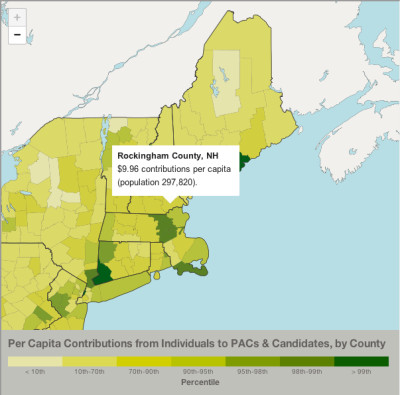 View Larger +
View Larger +
Prev
Next
23. Rockingham County, NH
Contributions, per capita, 2012: $9.96
Total contributions: $2,965,530
Rockingham has 37 communities and has a population of 297,820. Rockingham County also was home to the famous poet, Robert Frost
 View Larger +
View Larger +
Prev
Next
22. Belknap County, NH
Contributions, per capita, 2012: $10.02
Total contributions: $604,512
Belknap County is one of the ten counties in New Hampshire and has a population of 60,327. It is located in the center of New Hampshire and the largest city is Laconia.
 View Larger +
View Larger +
Prev
Next
21. Hampshire County, MA
Contributions, per capita, 2012: $10.41
Total contributions: $1,664,077
Hampshire County has a total area of 545 square miles and is located in the middle of Massachusetts. Hampshire County is also the only county to be surrounded in all directions by other Massachusetts counties.
 View Larger +
View Larger +
Prev
Next
20. Barnstable County, MA
Contributions, per capita, 2012: $10.90
Total contributions: $2,348,541
Barnstable County was founded in 1685 and has three national protected areas. Cape Cod National Seashore is the most famous protected area within Barnstable County and brings in a high amount of tourists every year.
 View Larger +
View Larger +
Prev
Next
19. Berkshire County, MA
Contributions, per capita, 2012: $12.49
Total contributions: $1,624,400
Berkshire County is located on the western side of Massachusetts and borders three different neighboring states. Originally the Mahican Native American Tribe inhabited Berkshire County up until the English settlers arrived and bought the land in 1724.
 View Larger +
View Larger +
Prev
Next
18. Essex County, MA
Contributions, per capita, 2012: $13.22
Total contributions: $9,991,201
Essex is located in the northeastern part of Massachusetts and contains towns such as Salem, Lynn, and Andover. Essex was founded in 1643 and because of Essex historical background, the whole county has been designated as the Essex National Heritage Area.
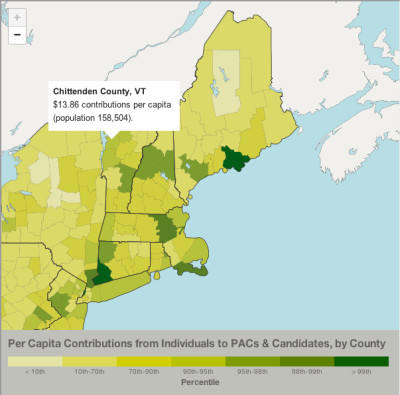 View Larger +
View Larger +
Prev
Next
17. Chittendon County, VT
Contributions, per capita, 2012: $13.86
Total contributions: $2,196,107
Chittenden has a population of 158,504, making it Vermont’s most populated county. Chittenden’s largest city is Burlington, which has about one third of Vermont’s total population.
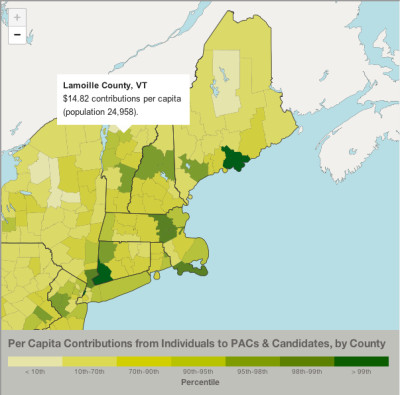 View Larger +
View Larger +
Prev
Next
16. Lamoille County, VT
Contributions, per capita, 2012: $14.82
Total contributions: $369,854
Lamoille County was founded in 1835 and has a population of 24,958. The county has 464 square miles, of which 461 of them are land.
 View Larger +
View Larger +
Prev
Next
15. Addison County, VT
Contributions, per capita, 2012: $15.49
Total contributions: $569,299
Located on the west side of Vermont, Addison County has a total area of 808 square miles. Addison's largest town is Middlebury, where the Community College of Vermont and Middlebury College are located.
 View Larger +
View Larger +
Prev
Next
14. Newport County, RI
Contributions, per capita, 2012: $16.02
Total contributions: $1,214,26
Newport County is one of the five Rhode Island Counties and was founded in 1703. Just like Connecticut, none of Rhode Island counties have an any governmental functions.
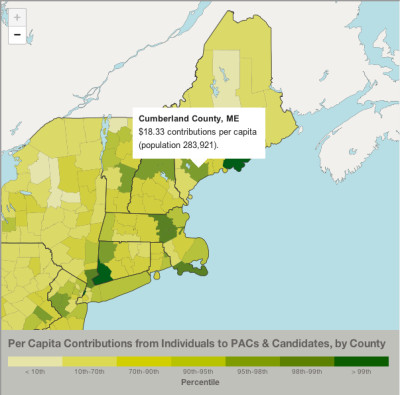 View Larger +
View Larger +
Prev
Next
13. Cumberland County, ME
Contributions, per capita, 2012: $18.33
Total contributions: $5,205,507
Cumberland County has a population of 283,921 and is Maine’s most populated county. The county was named after the William, Duke of Cumberland, a son of King George II.
 View Larger +
View Larger +
Prev
Next
12. Windsor County, VT
Contributions, per capita, 2012: $20.57
Total contributions: $1,156,149
Windsor County is the largest county in Vermont and consists of 971 square miles of land and 5 square miles of water.
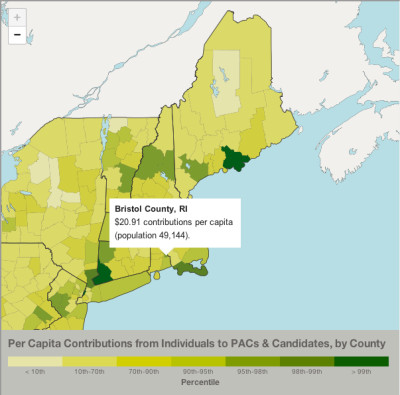 View Larger +
View Larger +
Prev
Next
11. Bristol County, RI
Contributions, per capita, 2012: $20.91
Total contributions: $1,027,472
Bristol County has a population of 49,144 and is the third smallest county in the United States. Bristol County was originally apart of Massachusetts, but was transferred to Rhode Island in 1746.
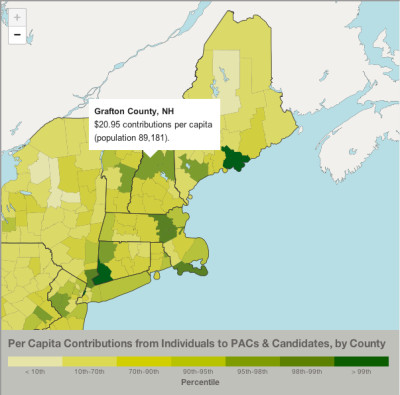 View Larger +
View Larger +
Prev
Next
10. Grafton County, NH
Contributions, per capita, 2012 :$20.95
Total contributions: $1,868,739
With a population of 89,181, Grafton County is the second largest county in New Hampshire. Home of New Hampshire’s only national forest, White Mountain National Forest takes up about half of Grafton’s total area
 View Larger +
View Larger +
Prev
Next
9. Carrol County, NH
Contributions, per capita, 2012: 2012: $22.81
Total contributions: $1,012,10
Created in 1840, Carroll County has a population of 47,567. Carroll County was also named after Charles Carroll, the last surviving signer of the United States Declaration of Independence.
 View Larger +
View Larger +
Prev
Next
8. LItchfield County, CT
Contributions, per capita, 2012: $22.86
Total contributions: $4,286,143
Although it is Connecticut’s largest county, Litchfield has the lowest population density in all of Connecticut. Since 1960 all Connecticut counties have no county government.
_400_395_90.jpg) View Larger +
View Larger +
Prev
Next
7. Middlesex County, MA
Contributions, per capita, 2012: $32.81
Total contributions: $50,432,154
Middlesex County has a population of 1,503,085 and has been ranked as the most populous county in New England. The county government was abolished in 1997, but the county boundaries still exists for court jurisdictions and other administrative purposes.
 View Larger +
View Larger +
Prev
Next
6. Nantucket County, MA
Contributions, per capita, 2012: $33.41
Total contributions: $344,021
Nantucket County consists of a couple of small islands and is a major tourist destination in Massachusetts. Normally Nantucket has a population of 10,298, but during the summer months the population can reach up to 50,000.
 View Larger +
View Larger +
Prev
Next
5. Norfolk County, MA
Contributions, per capita, 2012: $35.87
Total contributions: $24,459,854
Named after a county from England, Norfolk County is the wealthiest county in Massachusetts. As of 2011, Norfolk was ranked the 32nd highest income county in the United States.
 View Larger +
View Larger +
Prev
Next
4. Dukes County, MA
Contributions, per capita, 2012: $36.32
Total contributions: $618,960
Consisting of Martha’s Vineyard and the Elizabeth Islands, Dukes County is one of Massachusetts’ top vacation spots. Originally Dukes County was apart New York, however it was transferred to Massachusetts on October 7, 1691.
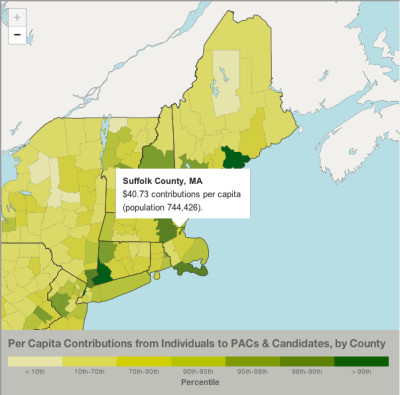 View Larger +
View Larger +
Prev
Next
3. Suffolk County, MA
Contributions, per capita, 2012: $40.73
Total contributions: $30,323,537
Suffolk County has a population of 744,426 and contains Massachusetts’s largest city, Boston. Although Suffolk’s county government was abolished in the late 1900’s, it still remains as a geographic area.
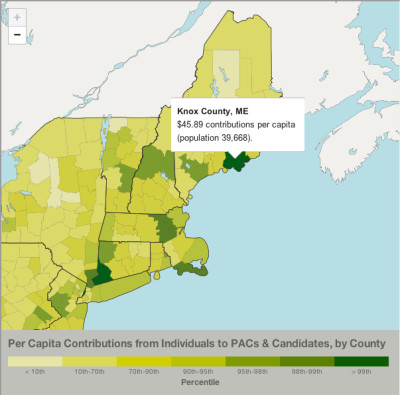 View Larger +
View Larger +
Prev
Next
2. Knox County, ME
Contributions, per capita, 2012: $45.89
Total contributions: $1,820,410
Knox County was established on April 1st, 1860 and was named after American Revolutionary War General Henry Knox. The county has a population of 39,668 and is the home of the Union Fair.
 View Larger +
View Larger +
Prev
Next
1. Fairfield County, CT
Contributions, per capita, 2012: $55.65.
Total contributions: $51,970,701
In a population of 933,835, Fairfield County is the most densely populated county in Connecticut, and contains four of the state's largest cities -- Bridgeport, Stamford, Norwalk and Danbury.
Related Articles
Enjoy this post? Share it with others.



_400_395_90.jpg)

















_400_395_90.jpg)






